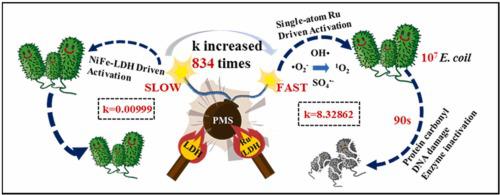Journal of Hazardous Materials ( IF 12.2 ) Pub Date : 2022-08-05 , DOI: 10.1016/j.jhazmat.2022.129720 Xin Zhou 1 , Zhongzhu Yang 1 , Yu Chen 1 , Haopeng Feng 1 , Jiangfang Yu 1 , Jialin Tang 1 , Xiaoyi Ren 1 , Jing Tang 1 , Jiajia Wang 1 , Lin Tang 1

|
The Fenton-like processes are considered to be one of the most promising strategies for inactivating bacteria due to their capacity to produce reactive oxygen species (ROS). Herein, a catalytic system for efficient inactivation of Escherichia coli (E. coli) was developed by anchoring single-atom Ru on layered double hydroxides (LDH). The Ru/NiFe-LDH catalyst showed excellent performance in activating peroxymonosulfate (PMS) to inactivate E. coli. Under the combined action of the ultra-low concentrations of Ru/NiFe-LDH (40 mg/L) and PMS (5 mg/L), 7 log E. coli can be totally inactivated within 90 s. This was attributed to the combined effect of single-atom Ru adsorption to E. coli and the ROS produced in situ. Mechanism studies indicated that the 1O2 with electrophilic properties was the key active species responsible for the rapid inactivation of E. coli. The E. coli inactivation process suggested that the ROS produced first attacked the outer membrane of the cell, then the antioxidant enzymes in the cell were induced, the macromolecule substances were released and mineralized, eventually leading to irreversible cell death. This work firstly loads monoatomic Ru on LDH for bacterial inactivation, providing a feasible method for rapid inactivation of E. coli.
中文翻译:

负载在层状双氢氧化物上的单原子钌催化过氧单硫酸盐通过非自由基途径有效灭活大肠杆菌:效率和机制
类芬顿过程被认为是灭活细菌的最有希望的策略之一,因为它们具有产生活性氧 (ROS) 的能力。在此,通过将单原子Ru锚定在层状双氢氧化物(LDH)上,开发了一种高效灭活大肠杆菌(E.coli )的催化体系。Ru/NiFe-LDH催化剂在活化过一硫酸盐(PMS)灭活大肠杆菌方面表现出优异的性能。在超低浓度Ru/NiFe-LDH(40 mg/L)和PMS(5 mg/L)的共同作用下,7 log大肠杆菌可在90 s内完全灭活。这归因于单原子Ru吸附对大肠杆菌的综合作用和原位产生的ROS。机理研究表明,具有亲电特性的1 O 2是导致大肠杆菌快速灭活的关键活性物质。大肠杆菌灭活过程表明,产生的活性氧首先攻击细胞外膜,然后诱导细胞内的抗氧化酶,释放大分子物质并矿化,最终导致不可逆的细胞死亡。该工作首次在LDH上加载单原子Ru进行细菌灭活,为大肠杆菌的快速灭活提供了一种可行的方法。











































 京公网安备 11010802027423号
京公网安备 11010802027423号